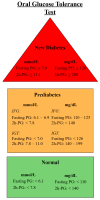Association of Low-Attenuation Plaque with Impaired Glucose Tolerance and Type 2 Diabetes Mellitus in Patients with Suspected Coronary Artery Disease
- PMID: 39857612
- PMCID: PMC11760424
- DOI: 10.3390/biomedicines13010028
Association of Low-Attenuation Plaque with Impaired Glucose Tolerance and Type 2 Diabetes Mellitus in Patients with Suspected Coronary Artery Disease
Abstract
Aim: The aim of this study was to evaluate the differences in plaque composition and burden between normal glycemic status (NGS) and dysglycemia expressed as impaired glucose tolerance (IGT) and type 2 diabetes mellitus (T2DM).
Methods: Clinically indicated coronary computed tomography angiography was used to evaluate patients with suspected coronary artery disease (CAD). An oral glucose tolerance test was performed to assess glycemic status. Patients were stratified as NGS, IGT, and T2DM. Plaque volumes were quantified using validated software, with further compositional measurements of low-attenuation, non-calcified, and calcified plaque burden.
Results: Of 355 patients with suspected CAD, 220 had NGS, 92 were diagnosed with IGT, and 43 with known T2DM. Low-attenuation plaque volume was significantly higher in IGT (209 mm3, p < 0.02) and T2DM (243 mm3, p = 0.005) compared with NGS (166 mm3). Total plaque burden was similar between all groups, but a significantly greater low-attenuation plaque burden was seen in IGT (p = 0.03) and T2DM (p = 0.02) compared with NGS. The multivariate linear regression model adjusted for clinical risk factors showed that patients with IGT had a greater low-attenuation plaque burden compared with those with NGS (p = 0.03). Interestingly, no significant differences in plaque burdens were observed between those with IGT and T2DM in both univariate and multivariate analyses.
Conclusions: Dysglycemia, including impaired glucose tolerance and type 2 diabetes mellitus, was associated with increased low-attenuation plaque burden compared with normal glycemic status. Patients with IGT demonstrated plaque burden similar to patients with known T2DM, underscoring the need for early metabolic intervention.
Keywords: computed coronary tomography angiography; dysglycemia; impaired glucose tolerance; low-attenuation plaque; plaque burden; plaque composition; type 2 diabetes mellitus.
Conflict of interest statement
The authors declare no conflicts of interest.
Figures
Similar articles
-
High-Risk Plaque Characteristics in Patients with Suspected Stable Coronary Artery Disease and Impaired Glucose Tolerance: A Coronary Computed Tomography Angiography Study.J Cardiovasc Dev Dis. 2025 Jan 22;12(2):37. doi: 10.3390/jcdd12020037. J Cardiovasc Dev Dis. 2025. PMID: 39997471 Free PMC article.
-
Presence, Characteristics, and Volumes of Coronary Plaque Determined by Computed Tomography Angiography in Young Type 2 Diabetes Mellitus.Am J Cardiol. 2017 May 15;119(10):1566-1571. doi: 10.1016/j.amjcard.2017.02.023. Epub 2017 Mar 1. Am J Cardiol. 2017. PMID: 28343599
-
Comparison of 64-slice multi-detector computed tomography coronary angiography between asymptomatic, type 2 diabetes mellitus and impaired glucose tolerance patients.J Cardiol. 2008 Oct;52(2):133-9. doi: 10.1016/j.jjcc.2008.06.009. Epub 2008 Aug 15. J Cardiol. 2008. PMID: 18922387
-
Development of type 2 diabetes mellitus in people with intermediate hyperglycaemia.Cochrane Database Syst Rev. 2018 Oct 29;10(10):CD012661. doi: 10.1002/14651858.CD012661.pub2. Cochrane Database Syst Rev. 2018. PMID: 30371961 Free PMC article.
-
Ethnicity, obesity and the prevalence of impaired glucose tolerance and type 2 diabetes in PCOS: a systematic review and meta-regression.Hum Reprod Update. 2018 Jul 1;24(4):455-467. doi: 10.1093/humupd/dmy007. Hum Reprod Update. 2018. PMID: 29590375
References
-
- Pararajasingam G., Høfsten D.E., Løgstrup B.B., Egstrup M., Henriksen F.L., Hangaard J., Egstrup K. Newly detected abnormal glucose regulation and long-term prognosis after acute myocardial in-farction: Comparison of an oral glucose tolerance test and glycosylated haemoglobin A1c. Int. J. Cardiol. 2016;214:310–315. doi: 10.1016/j.ijcard.2016.03.199. - DOI - PubMed
Grants and funding
LinkOut - more resources
Full Text Sources
Miscellaneous




